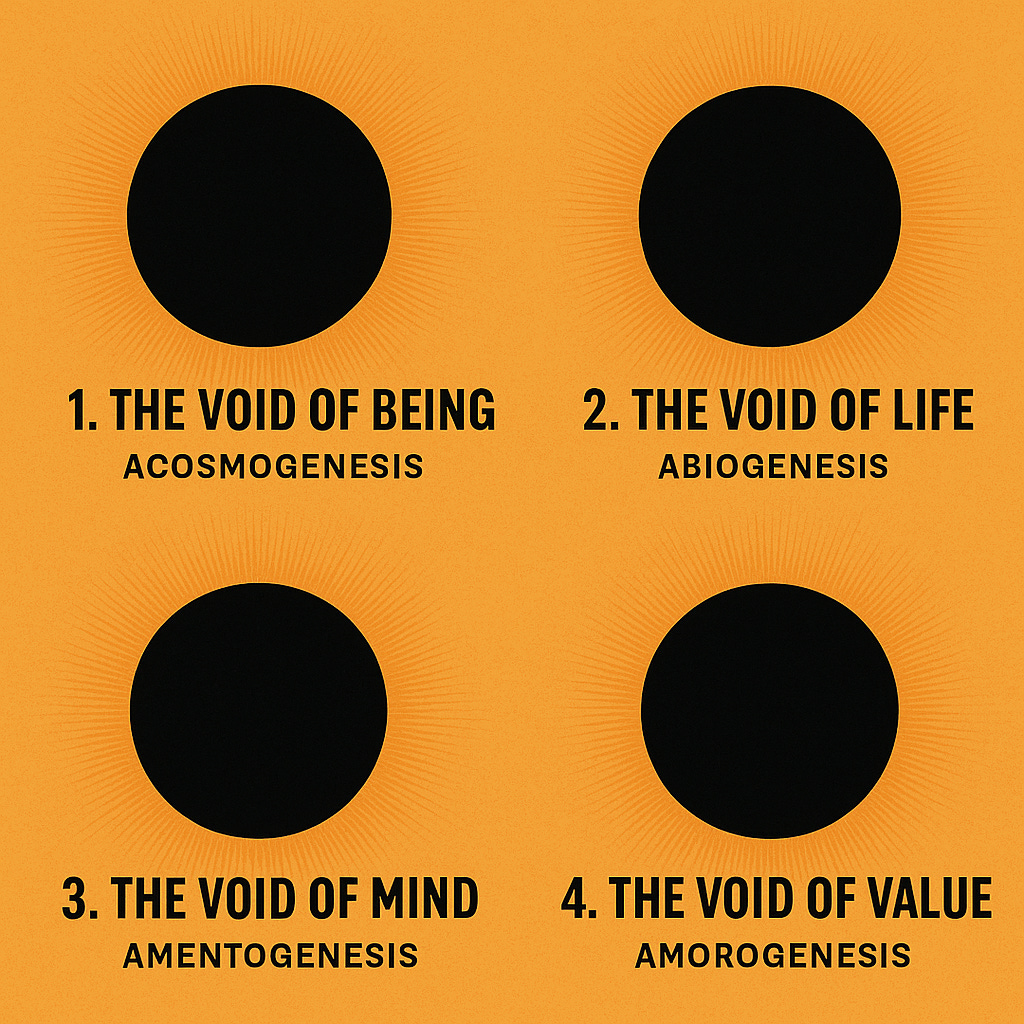Null Hypothesis: The Four Explanatory Voids of Atheistic Naturalism
Atheistic naturalism claims to be a worldview of reason, evidence, and intellectual courage. But beneath the surface lies a silent dependency, a borrowing of metaphysical capital it cannot repay. Strip away the rhetoric, and four unbridgeable voids remain. They are not gaps in scientific knowledge; they are fractures in the very foundation of naturalism itself.
1. The Void of Being:
Acosmogenesis
The first and deepest void asks a simple question: Why does anything exist at all?
Naturalism shrugs. The Big Bang just “happened.” Quantum vacuums, wave functions, multiverses—each is presented as a substitute for causation. But all of them already presuppose structure, symmetry, and mathematical law. You cannot build a universe from “nothing” if your “nothing” already contains the grammar of existence.
Theism grounds that grammar in a necessary mind, reason itself as the cause of reality. Naturalism halts at a brute fact and calls it science. That is not an explanation; it is resignation dressed in equations.
2. The Void of Life:
Abiogenesis
Life is not a collection of chemicals; it is chemistry wrapped in code. DNA carries information, executes instructions, and corrects its own errors. Information always implies reference, and reference is a mental relation, not a physical one.
Atheistic naturalism has no mechanism for how inert molecules become symbolic systems. “Self-replicating RNA” and “autocatalytic networks” describe clever chemistry, not semantics. Every lab experiment depends on human design to set conditions and define success. Life is meaning embodied, and meaning requires mind.
Theism explains life as the projection of divine rationality into the material order. Naturalism explains it as an accident that somehow behaves like intention.
3. The Void of Mind:
Amentogenesis
Consciousness is the most self-evident reality you will ever experience. Yet naturalism treats it as a glitch in neural computation, an illusion produced by matter that is not aware. But an illusion to whom?
Material explanations describe functions, not awareness. You can simulate thought, but you cannot get “thinking about thinking” from matter alone. Even the smartest AI predicts patterns; it does not understand them. Rationality presupposes intentionality, and intentionality requires a subject, a “who,” not a “what.”
Theism locates mind at the top of the metaphysical chain; naturalism tries to conjure it at the bottom and collapses into self-refutation. You cannot use reason to prove that reason is an accident.
4. The Void of Value:
Amorogenesis
Morality is the final fracture. Naturalism says values are evolved instincts, useful illusions for social survival. But moral realism does not survive in a world of pure physics. If every act is the byproduct of chemical determinism, there is no real “ought,” only preference.
Yet every human being lives as if good and evil are real, as if justice matters, as if love is more than neurochemistry. That intuition is not evolutionary noise; it is a memory of moral design.
Theism grounds value in the character of a good Creator. Naturalism grounds it nowhere, and then borrows moral language from the worldview it rejects.
The Pattern Behind the Voids
Each void is a mirror image of the same failure: naturalism cannot cross the boundary from description to explanation, from mechanism to meaning. It begins with reason, consciousness, and moral law as facts of experience, and then builds a worldview that makes them impossible.
You can explain how matter moves, but not why it means anything. You can describe the universe’s behavior, but not why it exists. You can model cooperation, but not obligation. The atheist can compute the shadows, but the light that casts them is gone.
The Theistic Resolution
The four voids are not isolated mysteries; they converge on one truth. Being, life, mind, and value all share the same signature—they are rationally structured realities. And rational structure demands a rational source.
“In the beginning was the Word.” The Logos, reason itself, is not an invention of man but the foundation of everything that is. Theism begins where naturalism ends, with logic as law, mind as cause, and love as the reason creation exists at all.
Naturalism explains process but not possibility. Theism explains both.
The choice is stark:
A closed system that cannot justify its own coherence,
or a rational Creator who grounds it all.
Four voids, or one Logos.
oddXian.com | Where logic and faith converge.


